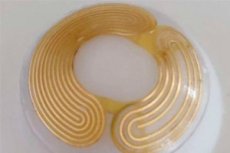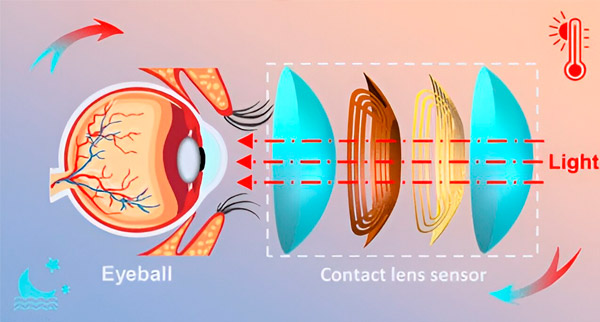Nye publikasjoner
Smarte linser kan oppdage glaukom trådløst
Last reviewed: 02.07.2025

Alt iLive-innhold blir gjennomgått med medisin eller faktisk kontrollert for å sikre så mye faktuell nøyaktighet som mulig.
Vi har strenge retningslinjer for innkjøp og kun kobling til anerkjente medieområder, akademiske forskningsinstitusjoner og, når det er mulig, medisinsk peer-evaluerte studier. Merk at tallene i parenteser ([1], [2], etc.) er klikkbare koblinger til disse studiene.
Hvis du føler at noe av innholdet vårt er unøyaktig, utdatert eller ellers tvilsomt, velg det og trykk Ctrl + Enter.

De fleste med glaukom i tidlig stadium er ikke klar over at de har sykdommen, selv om tidlig behandling er avgjørende for å redusere synstap. Å oppdage en liten økning i øyetrykket hjelper leger med å diagnostisere glaukom, men det er vanskelig å overvåke dette trykket regelmessig, spesielt gitt det store temperaturspekteret øyet utsettes for. Nå rapporterer forskere ved ACS Applied Materials & Interfaces en prototype av en «smart» kontaktlinse som nøyaktig måler øyetrykket uavhengig av temperatur.
Ifølge Centers for Disease Control and Prevention (CDC) har rundt 80 millioner mennesker verden over glaukom, en gruppe sykdommer som skader synsnerven og fører til synstap. Leger bruker en "pneumotonometer-test" under en øyeundersøkelse for å måle trykket inne i øyet én gang. En liten økning i trykket, et knapt merkbart symptom forårsaket av væskeansamling rundt hornhinnen, kan føre til en glaukom- diagnose.
Forskere tester måter å kontinuerlig og mer komfortabelt oppdage disse små trykksvingningene, for eksempel kontaktlinser som overfører signaler til spesielle briller. Temperaturendringer, for eksempel å gå ut i kulden, kan imidlertid forvrenge linsenes målinger. Så forsker Dengbao Xiao og kollegene hans satte seg fore å utvikle en kontaktlinse som nøyaktig måler og trådløst overfører sanntidsdata om intraokulært trykk over et bredt temperaturområde.

Xiaos team utviklet i utgangspunktet to miniatyrspiralkretser, hver med et unikt naturlig vibrasjonsmønster som endret seg når de ble strukket, for eksempel med endringer i trykk og øyediameter. For å lage trykkfølsomme kontaktlinser, klemte forskerne disse små kretsene mellom lag med polydimetylsiloksan, et standard kontaktlinsemateriale.
Deretter leste de vibrasjonsmønstrene til de innebygde kretsene ved hjelp av en spole koblet til en datamaskin og plassert ved siden av linsen. De overførte signalene ble ikke påvirket av tester som simulerte øyebevegelser, langvarig eksponering for fuktighet (for å simulere våte forhold i øyet) og daglig bruk.
I laboratorietester plasserte forskerne de nye linsene på tre griseøyneprøver, og overvåket intraokulært trykk og temperatur. Linsene overvåket og overførte trådløst trykkdata ved temperaturer fra 10 til 50 grader Celsius. Da trykket ble beregnet ved hjelp av bare én krets i linsen, var resultatene opptil 87 prosent feil. Men når man brukte informasjon fra begge kretsene, var trykkavlesningene bare 7 prosent feil, ettersom kombinasjonen av kretser eliminerte temperaturrelaterte feil.
Forskerne sier at deres smarte linsedesign med dobbel chip har potensial til å nøyaktig oppdage og overvåke glaukom tidlig, selv over et bredt temperaturområde.
